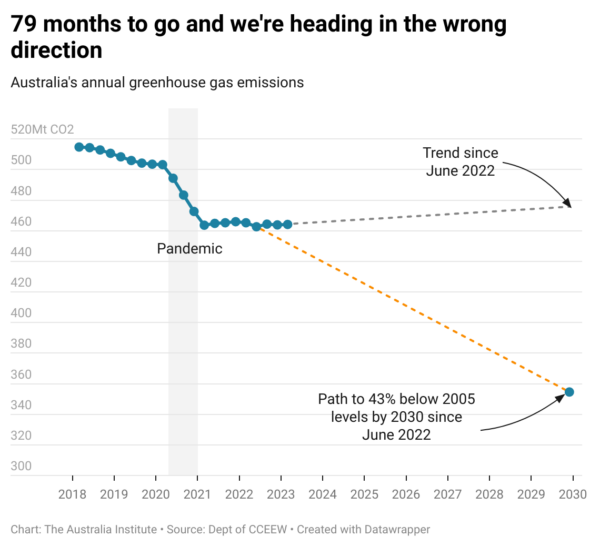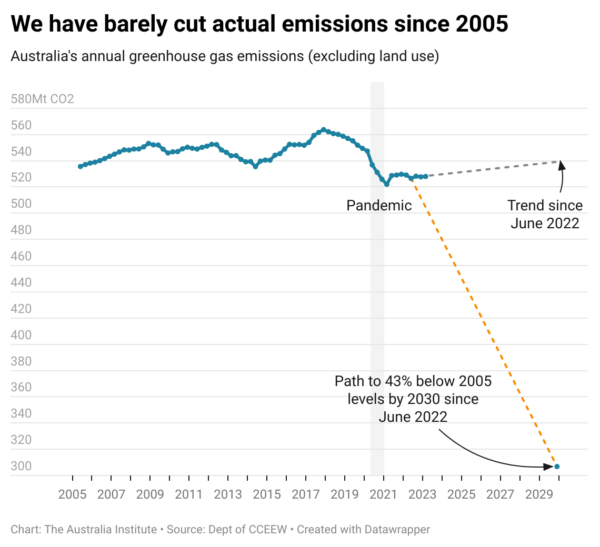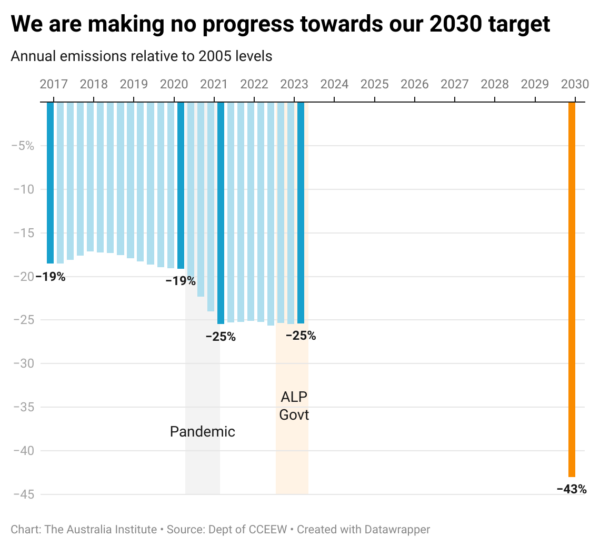Time is running out to reach our emissions target, and our path needs changing
With less than 7 years to go till 2030 we cannot wait to transition away from coal and gas
The Minister for Climate Change and Energy, Chris Bowen, has made a habit of reminding us just how little time we have left to meet our 2030 climate target.
In May, for example, he told the Corangamite Climate Forum Australia only has “80 months” to decarbonise the Australian economy.
It’s now June and that means there are only 79 months to reduce Australia’s emissions by 43% below 2005 levels. Despite the urgency, the latest greenhouse gas emissions data however shows how off track we are.
Far from heading towards a 43% cut, since the end of 2020, Australia’s emissions have been rising.

The orange dotted line shows where we should be headed. The grey dotted line shows where we are in 2023 ( just 25% below 2005 levels) and where we should be headed. It’s not great.
But unfortunately, that is actually the good news.
The above graph include emissions from “land use”. Very roughly what this means is that the Australian government counts how much carbon dioxide (CO2) has been sucked up by trees and is stored in soil. It then subtracts that from the overall amount of CO2 emitted and comes up with Australia’s ‘net emissions’.
It’s a risky way to manage your climate accounts because the land sector is very vulnerable to the impacts of climate change. A hotter and drier climate means our vegetation is at increasing risk, and the soil is losing more carbon than ever. It’s also really hard to measure exactly how much carbon is being stored. No one is out there counting trees. Australia counts its land sector emissions using modelling and satellite imagery.
The government really likes counting the land sector because it’s a convenient way to mask rising emissions across other areas of the economy (like…fossil fuels). There’s quite a bit of fudging and recalculating when it comes to how much Co2 the land is absorbing or emitting. Funnily enough, in the latest data, the government said that a satellite had been playing up and there were actually far more trees than they had realised, making Australia’s ‘net’ emissions even lower than they thought!
Including land use enables Australia to claim a reduction in emissions that does not involve actually reducing emissions, but rather just being less bad at cutting down trees than it was in the past.
It was this reasoning that was behind the Howard government lobbying for the so-called “Australia clause” in the Kyoto Protocol. As the Parliamentary Library notes,
“the Australia Clause”… allows nations for which land use, land use change and forestry (LULUCF) were a net source of emissions in 1990 to add these emissions to their base-year calculations (which were used to determine emission targets). Australia was one of the few nations that were in this position in 1990 and recent analysis shows that Australia benefitted the most from this clause”.
Removing land use give a much more honest recording of emissions produced by a nation. And doing so demonstrates that, since 2005, Australia has only cut emissions by 2% not 25%. There’s a lot of work to do in the next 79 months.

The problem is that over the past six years the only reductions in emissions came during the pandemic when we saw not unprecedented lockdowns that greatly reduced emissions due to less activity, especially of transport.
From 2017 till the start of the pandemic emissions remained largely stable at 19% below 2005 levels. The pandemic saw a sharp fall to 25% below 2005 levels, but that is where it has remained ever since.
In reality to reach a target of emissions by 2030 in line with that proposed by organisations such as the climate council of 75% below 2005 level, we would need emissions to fall at roughly the rate they did during the pandemic. Instead they are at best remining stable.

But once again the above chart is the good news. The path from being 25% below 2005 levels to 43% seems within range. But that chart again includes land use. When we exclude land use to get the honest picture of Australia’s emissions we see just how much far we have to go and how urgent is the task.

Minister Bowen is correct to warn that we are getting ever closer to the 2030. but we cannot achieve our targets, let alone ones more aligned with the science, by approving new coal and gas mines.
We cannot keep talking of a gas-led transition. The time to shift to renewables is now. Thus far there has been little sign of any reduction in Australia’s emissions since the election of the Albanese government. And perhaps it is too soon.
But since the election we have used up 13% of the time till 2030.
Time, as Minister Bowen knows only too well, is running out.
Related research
Between the Lines Newsletter
The biggest stories and the best analysis from the team at the Australia Institute, delivered to your inbox every fortnight.
You might also like
LULUCF explained: Why Australia’s emissions aren’t actually going down
Australia’s emissions reduction claims simply don’t add up.
Integrity at home shapes global outcomes – Polly Hemming | Climate Integrity Summit 2025
Despite frequent claims that Australia is ‘too small to make a difference,’ historical evidence demonstrates our nation’s outsized role in influencing international norms and policies.
We need political courage, not caution
When it comes to solving the biggest national problems, a bit of courage leaves political caution for dead. Now’s not the time for politeness.



